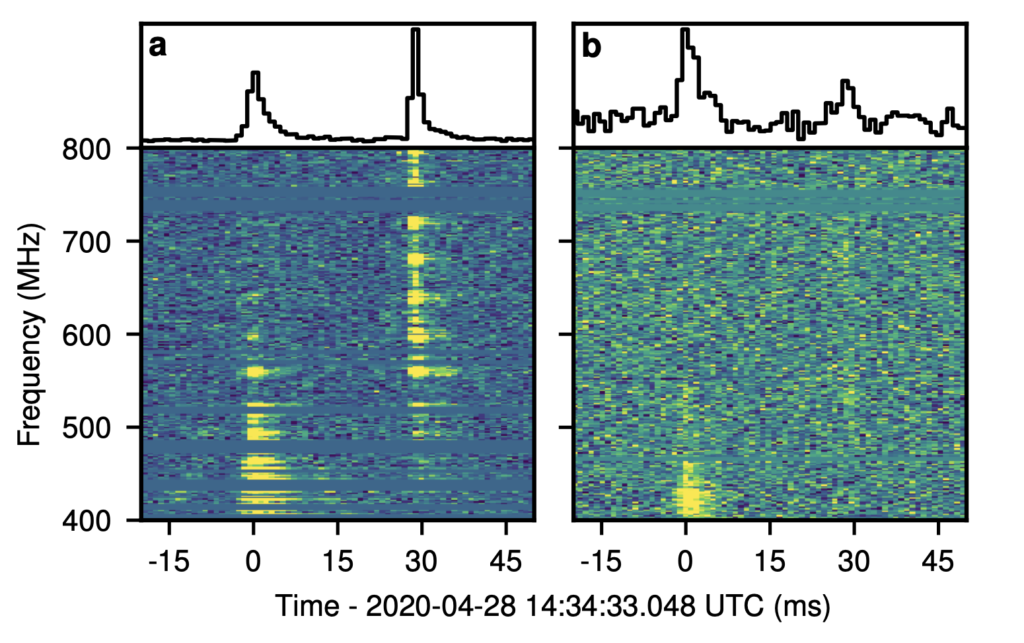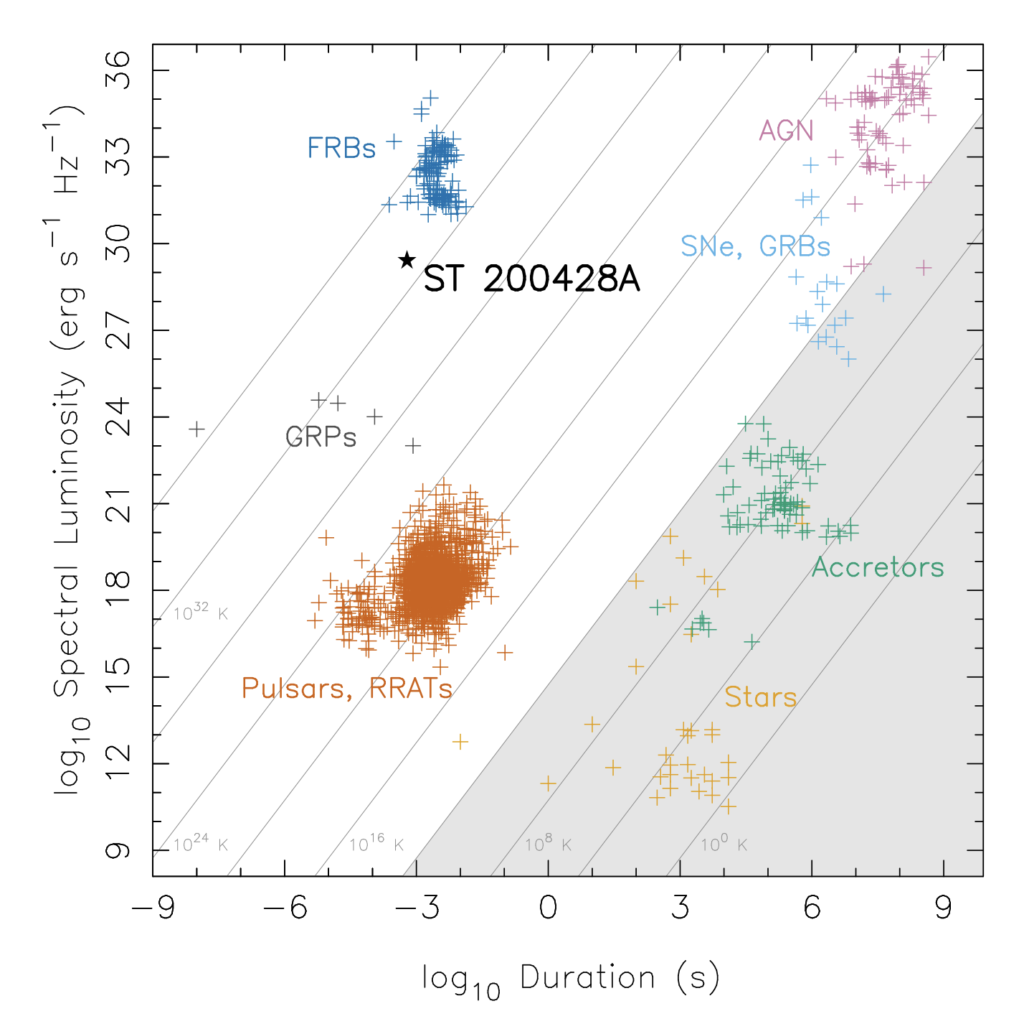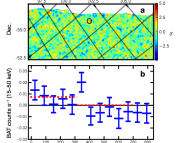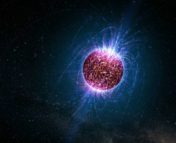Title: A bright millisecond-duration radio burst from a Galactic magnetar
Authors (bold indicates corresponding author): The CHIME/FRB Collaboration: B. C. Andersen, K. M. Bandura, M. Bhardwaj, A. Bij, M. M. Boyce, P. J. Boyle, C. Brar, T. Cassanelli, P. Chawla, T. Chen, J. -F.Cliche, A. Cook, D. Cubranic, A. P. Curtin, N. T. Denman, M. Dobbs, F. Q. Dong, M. Fandino, E. Fonseca, B. M. Gaensler, U. Giri, D. C. Good, M. Halpern, A. S. Hill, G. F. Hinshaw, C. Höfer, A. Josephy, J. W. Kania, V. M. Kaspi, T. L. Landecker, C. Leung, D. Z. Li, H. -H.Lin, K. W. Masui, R. Mckinven, J. Mena-Parra, M. Merryfield, B. W. Meyers, D. Michilli, N. Milutinovic, A. Mirhosseini, M. Münchmeyer, A. Naidu, L. B. Newburgh, C. Ng, C. Patel, U. -L.Pen, T. Pinsonneault-Marotte, Z. Pleunis, B. M. Quine, M. Rafiei-Ravandi, M. Rahman, S. M. Ransom, A. Renard, P. Sanghavi, P. Scholz, J. R. Shaw, K. Shin, S. R. Siegel, S. Singh, R. J. Smegal, K. M. Smith, I. H. Stairs, C. M. Tan, S. P. Tendulkar, I. Tretyakov, K. Vanderlinde, H. Wang, D. Wulf, A. V. Zwaniga
Corresponding Author’s Institution: Dunlap Institute for Astronomy & Astrophysics, University of Toronto, 50 St. George Street, Toronto, ON M5S 3H4, Canada
Status: Submitted to Nature, open access on arXiv
AND
Title: A fast radio burst associated with a Galactic magnetar
Authors: Christopher D. Bochenek, Vikram Ravi, Konstantin V. Belov, Gregg Hallinan, Jonathon Kocz, Shri R. Kulkarni, Dan L. McKenna
Corresponding Author’s Institution: Cahill Center for Astronomy and Astrophysics, MC 249-17, California Institute of Technology, Pasadena CA 91125, USA/Owens Valley Radio Observatory, MC 249-17, California Institute of Technology, Pasadena CA 91125, USA.
Status: Submitted to Nature, open access on arXiv
This astrobite is about a single event that was detected by two collaborations simultaneously so we’ll discuss the results of both papers.
Fast radio bursts (FRBs) are extremely energetic radio bursts lasting only milliseconds. Some repeat and some are single bursts, never to be detected again. They are extragalactic in origin and some have now been localized to other galaxies. (For more background on FRBs, check out astrobites such as this one and this one). The number of extragalactic FRBs detected is now in the hundreds thanks to the Canadian Hydrogen Intensity Mapping Experiment (CHIME) radio telescope, and continues to grow. Yet, despite the many existing theories, we don’t know what the sources of these bursts are, and we had yet to detect an FRB from within the Milky Way. Until now.
On April 28, 2020, both CHIME and STARE2 (an array of radio telescopes across the south-western United States) detected a bright burst of emission from the magnetar SGR 1935+2154. Magnetars (discussed more in this astrobite) are neutron stars with extremely strong magnetic fields of more than a billion Tesla. For comparison, some of the strongest magnets on Earth, neodymium magnets, only have a magnetic field strength of ~1 Tesla. This detection is exciting not only because this could be a Galactic FRB, but also because magnetars have long been thought to be a source of FRBs.
Could this really be an FRB?
One of the keys to determining if this burst is FRB-like is looking at its various properties, such as how long it lasted and how bright it was. However, since these instruments observe at different radio frequencies, CHIME operates from 400-800 MHz and STARE2 operates from 1281-1468 MHz, the reported properties may be slightly different.

First we can look at the duration of the burst. From Figure 1, we can see the burst detected by STARE2 was about 0.7 ms duration. In Figure 2, the burst detected by CHIME has two peaks (typical of many FRBs), which were about 0.6 and 0.3 ms long respectively. These durations are consistent with the expected durations from other observed FRBs, so that’s one check. Then we can look at how bright the bursts were. This is typically done by looking at the fluence, or total energy released over the duration of the burst. The STARE2 burst has a fluence of 1.5 MJy ms (that’s mega-jansky milliseconds) and the CHIME bursts had a fluence of 480 and 220 kJy ms (or kilo-jansky milliseconds). These are both over a thousand times brighter than any observed radio pulse from a known magnetar at their respective frequencies! While the energetics of this burst from SGR 1935+2154 are still 40 times weaker than any observed extragalactic FRB (see Figure 3), the STARE2 collaboration estimated that if this burst had come from the location of other nearby repeating FRBs it would be detectable.

One final key to checking if this might be an FRB is that there was also an X-ray burst detected at the same time as the radio burst. Figure 1 shows when the X-ray burst occurred relative to the STARE2 detection of this burst. This supports the idea that there is a link between X-ray outbursts and FRBs if they are produced by magnetars, match up with many emission models.
Where does this burst fit with the known FRB population?
The energy, duration, source, and X-ray counterpart to this radio burst from SGR 1935+2154 all support the idea that this is a Galactic FRB. But how does it really compare to other radio bursts, not just FRBs, but giant radio pulses (GRPs) , normal pulsar emission, and other phenomena? Figure 3 shows just how the energy of this burst compares to the energy of bursts from lots of different astronomical objects and how long those bursts last.

The burst from SGR 1935+2154 has a comparable length to FRBs, though less energetic. However, the authors of both papers agree that based on these properties this burst is probably from the same population as the FRBs. In other words, they conclude that one source of FRBs are magnetars like SGR 1935+2154, making this first confirmed source of these mysterious extragalactic bursts. In fact, both groups say that, given the predicted number of magnetars in other galaxies, magnetars similar to SGR 1935+2154 could be the dominant (though not the only) source of FRBs, producing up to 10,000 bursts per cubic giga-parsec per year, comparable to the predicted volumetric rate of FRBs.
How much is left of the FRB puzzle?
Despite this groundbreaking detection, FRBs are far from a solved problem. While we may have observed the most prolific producers of FRBs, both collaborations agree that these types of bursts from magnetars like SGR 1935+2154 probably cannot account for all observed FRBs. In particular, bursts like the one observed here cannot account for highly energetic repeating bursts like those observed from FRB 121102. While there are few of these types of FRBs observed so far, they make up an important part of the population in need of explanation. So while a major piece of the FRB puzzle may have been solved, there are many more exciting discoveries to be made in this field.




